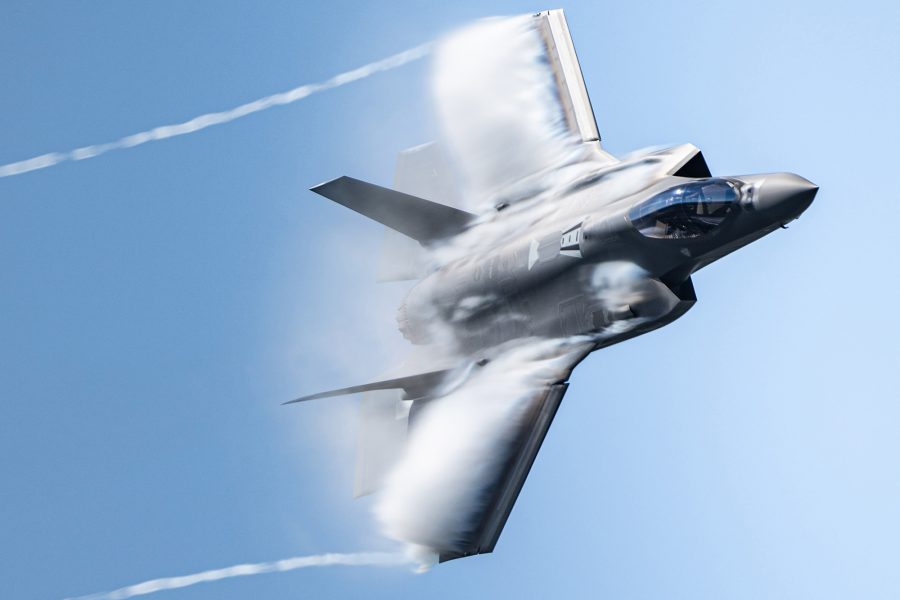The year 2024 will stand as a transformative year for modernizing the U.S. Air Force’s fighter force. Bottom line: the service needs to reset fast. That is why it was welcome news when Lockheed Martin recently announced the Tech Refresh 3/Block 4 variant of its F-35 are projected to join operational Air Force units by the third quarter of this year.
This much-needed injection of new airframes and their advanced warfighting capabilities comes at a time when the Air Force’s fighter inventory is too small and too old to meet real-world global demands. Yet even as Tech Refresh 3/Block 4 F-35s roll off the line, there are threats to fiscal 2025 airframe orders. Money is tight, leaders are frustrated over program delays, and Congress is facing spending caps. But slowing F-35 buys would be a serious mistake, posing grave risk to long-term Air Force readiness in the face of growing threats.
The Air Force must rapidly rebuild a fighter inventory that has grown old and weary to match the pacing threat—China—and that means buying as many of the Block 4 F-35s as it can at the fastest possible rate.
One need only look at Ukraine to see what happens when a nation lacks a strong fighter force. Friendly forces are vulnerable to enemy aerial attack and the inability to penetrate air defenses renders a nation unable to strike targets at a decisive scale behind an adversary’s lines. The result we see today was predictable: Ground forces dug into fixed positions as in World War I, locked in an incredibly brutal, grinding battle in which both sides suffer high casualties and neither makes progress.
This is a nightmare scenario U.S. forces could suffer as well, if our military cannot demonstrate an airpower advantage against a peer competitor. Adversaries like China will always win a numbers contest in a fight close to their homeland. They own the advantage in sheer size, would be closer to their supply base, and have local air defenses to shield their forces.
Preventing a mass-on-mass war of attrition demands a more strategic approach to combat—the ability to strike anywhere in the battlespace with decisive force, while concurrently protecting against the enemy doing the same. That requires a right-sized fighter aircraft inventory.
We have seen this before. In World War II, the P-51 was the lynchpin of the air war in Europe, enabling our bombers to inflict damage on the continent. Later in Korea, F-86s dogfighting over MiG alley earned iconic status. Deterrence in Europe during the Cold War hinged on U.S. F-15s, F-16s, and A-10s, which gave the U.S. air superiority and a crushing counter to the numerical advantage in ground forces boasted by the Soviet-led Warsaw Pact. These aircraft and their pilots set the conditions to deter adversaries from challenging the U.S. and defeat them if they did.
Unfortunately, post-Cold War hubris and a myopic focus on ground operations after 9/11 ground down the U.S. fighter force. Rather than maintain the advantage, thousands of aircraft were retired, pilot ranks were decimated, and production of the most capable combat fighter ever built—the F-22—was terminated at less than half its original requirement. All this was done in the name of fiscal responsibility in the face of mounting costs for the wars in Afghanistan and Iraq.
Today we know differently. The rapid rise of China, Russia’s aggression against Ukraine, perennial instability in the Middle East, and the nuclear ambitions of Iran and North Korea make clear that risks taken in the fighter inventory went too far. These risks have allied air forces around the globe—including the U.S. Air Force—scrambling to reset their capacity and capability to counter mounting threats.
The F-35 is the only stealthy U.S. fighter in production with the mission attributes needed to succeed in modern threat environments. That’s why so many nations, from the United Kingdom and to Israel, Italy to Australia, and the Netherlands to Japan are all lining up to buy this airplane. It dominates fighter competitions in almost every international market.
Recent delays in the program are tied to comprehensive upgrades that will radically enhance the aircraft’s performance against top-end threats, especially those posed by China. They amount to one of the largest software upgrades ever tackled by the Department of Defense. These delays have frustrated the Pentagon and Congress, but they should not trigger moves to undercut the program. Mission imperatives must prevail.
Short-term decisions to delay or limit procurement will have long-lasting consequences. The F-35s authorized and paid for by Congress in the fiscal year 2025 budget will not land on Air Force runways until the latter part of the decade. The bureaucratic process of moving money, securing long-lead supplies, and acquiring all the component parts takes time. Cuts made now will hit the force three or more years down the road, by which time the latest upgrade challenges will be long solved. Such actions would deprive the service of combat capacity it badly needs and damage the supplier base. This is self-defeating.
Fighter aircraft underpin the viability of the entire joint force. Ships at sea, forces on land, space and cyber centers, and rear bases are all vulnerable to aerial attack. Fighter aircraft are vital to their defense, and fighters are crucial to U.S. and allied power-projection strategies. Limiting procurement of fighter aircraft today that will be delivered fully combat ready three years from now will degrade overall our military’s effectiveness. This is not a rational choice. It’s a dangerous course. This is why F-35 procurement must be maximized, not cut at a time when the risk of conflict is growing. Let’s not send the wrong signals to America’s adversaries.
Douglas A. Birkey is the executive director of the Mitchell Institute for Aerospace Studies.


